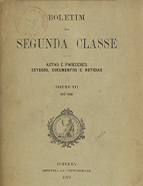

................................
In 1917 and 1918, a controversy arose within the Class regarding a regulatory norm common to institutions of this kind: the elevation or promotion of corresponding members to full membership (similar to the ACL’s 19th-century practice of promoting free members to full membership). At the session on 22 February 1917, opinions from Cândido de Figueiredo and Henrique Lopes de Mendonça were read regarding the proposals for two new full members: Afonso Costa (former President of the Council of Ministers) and Bernardino Machado, then President of the Republic (Vol. XI, 1916–1917, pp. 42–46). This prompted Joaquim José Coelho de Carvalho, the president of the Class, to express his regret that "one of the Academy’s corresponding members, natural-born candidates for the position, was not favoured to fill the vacancy" (Idem, p. 39). On 8 March, a debate ensued over whether Article 1 of the regulation dated 1 July 1868— which designated corresponding members as "natural candidates" for full membership— had become a dead letter. Júlio Dantas argued that beyond formal regulations, there was an "old practice" of recognising precedence for such positions (Idem, pp. 48–49).
Despite these considerations, the following year, in 1918, Afonso Costa was elected by nine votes, with one abstention— that of Joaquim José Coelho de Carvalho, who justified his position by stating that he could not prefer "a person who was still a stranger to [the ACL] over some of the corresponding members, and for no other reason" (Vol. XII, 1917–1918, p. 601).
Volume XII (1917–1918) of the Boletim da Segunda Classe spans 599 pages, the majority of which consist of analyses and transcriptions of documents. The influence of António Ferrão, a prominent publicist known for his extensive documentary studies, is particularly evident in the final volumes of this series: Volumes XIX, XX (Part 1), and XX (Part 2), covering the years 1924–1925 and 1926–1929, although they were likely not printed until after 1932 (two volumes are undated). In the penultimate volume, Ferrão proposed suspending the publication of the Quadro Elementar [Elementary Chart], which had ceased in 1876, and replacing it with "a collection of diplomatic instructions." He also suggested reviving the long-interrupted Corpo Diplomático [Diplomatic Corps], which had been dormant for 62 years. Among his ambitious proposals was the creation of a Portuguese mission to the Vatican archives and the establishment of "a Portuguese historical institute in Rome, dependent on this Class.” He was even appointed to travel "abroad" to gather materials that could serve as the basis for writing a History of Portugal— a project that had been an ambition of the Academia das Ciências [Academy of Sciences] since the late 18th century— and a History of Portuguese Culture. However, neither project was ever realised (Vol. XX (1st part), n.d., pp. 28–29 and 38). The Boletim was initially printed in Lisbon at the ACL during the first five volumes (1903–1912), covering the years 1898–1911. Additional volumes were printed in 1915 (Vol. IX) and the final two volumes (Vol. XX, Parts 1 and 2, n.d.). The remainder, from Vol. VI–VIII (1913–1914) and Vol. VIII (1916) through to Vol. XIX (1933), were printed in Coimbra. The Boletim da Academia das Ciências [Bulletin of the Academy of Sciences], which succeeded the Boletim da Segunda Classe , was printed in Coimbra starting in 1929 before moving back to Lisbon in 1935. The Boletim da Segunda Classe existed in nomine solely to fulfil its role as a repository for minutes and opinions until 1929, after which it coexisted with a new or second series.
This work is financed by national funds through FCT - Foundation for Science and Technology, I.P, in the scope of the projects UIDB/04311/2020 and UIDP/04311/2020.
